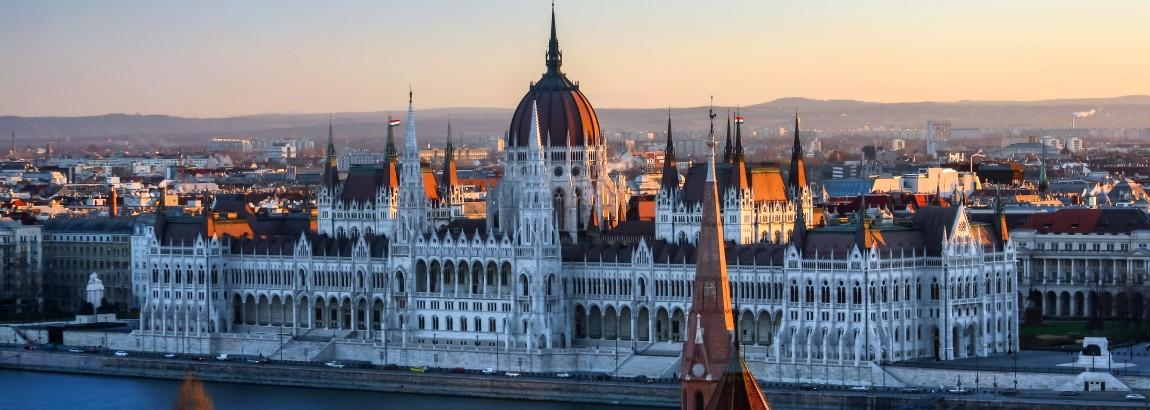
| City - Airport | Departure: | ||
| Iasi | Chisinau | ||
| to Budapest (BUD) | IAS → BUD | RMO → BUD | |
| - Liszt Ferenc/Ferihegy (BUD) | IAS → BUD | RMO → BUD | |
The funicular takes you up to the Castle Hill, where the Old Town of Buda and the Budapest History Museum are located, whose collection introduces the history of the city from the Roman era.
District I (Castle District) - the smallest in the Buda area, where Buda Castle is located.
Along the Danube, below the castle and to the north, lies the Vizivarosh region (Districts I, II, and III). It features contemporary-style fountains from the early 20th century, medieval "Király" and "Lukács" baths with interesting architectural solutions, including cathedrals founded in the Middle Ages. Pal-Voldi stalagmite cave, the most visited of all Budapest's underground labyrinths, is also here.
Gellert Hill, south of Castle Hill, "competes" with Janos Hill, which is much further away, for the title of the city's best viewpoint. At its base, since 1918, the hotel of the same name in Art Nouveau style has welcomed guests; it is renowned beyond Hungary's borders for its thermal baths.
District III (Obuda) is a quiet area where tourist attractions perfectly coexist with residential neighborhoods and panel houses. Here, you'll find the ruins of Aquincum - a city that was part of one of the outer provinces of the Roman Empire. Two amphitheaters have survived. Other sites are also tied to the history of Obuda: Sentlelek Square (Szentlélek tér) and the Zichy family palace, Fo Square (Fő tér) with the Town Hall and sculptures by the Hungarian Imre Varga.
Pest features large buildings and a grid-like layout of boulevards.
Across the river from the castle complex stretches the Belvarosh district, the old core of the city, where some of the earliest buildings preserved from the 12th century can be found (e.g., the parochial church). Directly in front of the church, the ruins of a small Roman fort are preserved.
The riverside street has been reconstructed for leisurely strolls—from here, you can admire Buda.
In Belvarosh, as well as the entire central region of Pest, there are numerous monuments to famous Hungarians—a sort of national showcase of statehood.
From Vörösmarty Square begins Vaci Street, a pedestrian zone bustling with tourists both day and night. The majestic city council building and the university library are not far from the equally majestic Central Market.
Liptovarosh is famous for its bridges: the Chain Bridge (Széchenyi) became the first permanent crossing between the two banks in the mid-19th century, and the Princess Margaret Bridge, built shortly thereafter, broke the record for the number of reconstructions.
The main street of District IV (Terezvarosh) is Andrassy Boulevard, broad and straight. Compared to the Champs Elysees, it might not sound as grand, but it is one of the most popular streets in Budapest, where palaces and villas from the 19th and 20th centuries are built.
The boulevard is bordered by District XIV, where Heroes' Square and the City Park are located (the largest in Europe and heavily promoted among tourists with the Széchenyi baths, as well as an eclectic complex of buildings in various architectural styles found across the country, popularly known as Vaydahunyadvar).
District VII nearby is noted not only for its proximity to the old center and contemporary-style buildings but also for the Jewish quarter Erzsébetváros (built in the 18th and 19th centuries). The Great Synagogue on Dohany Street, with a capacity of up to 3,000 people, remains one of the largest in Europe.
Józsefváros (District VIII), to the north, is bounded by Rakoczy Boulevard, notable for the old "Kerepesi" cemetery opened in 1847. In the same area and year, the National Museum, the first museum in Hungary's history, was opened.
The city also encompasses the 7 islands on the Danube, including, in fact, Palotai Peninsula.
Margaret Island, in the city center, is part of District XIII and is entirely transformed into a leisure park.
The main temple in Buda, the Church of the Virgin: the first mention dates back to the 13th century. The temple survived the Turkish invasion, after which it served as the city's main mosque for half a century.
Gödöllő (a location 30 km from the capital, easily accessible by HEV suburban train) also boasts a royal palace, built in the first half of the 18th century. The residence was graced with royal favor: Franz Joseph I liked to stop here for extended periods.
Airports:
Airports: